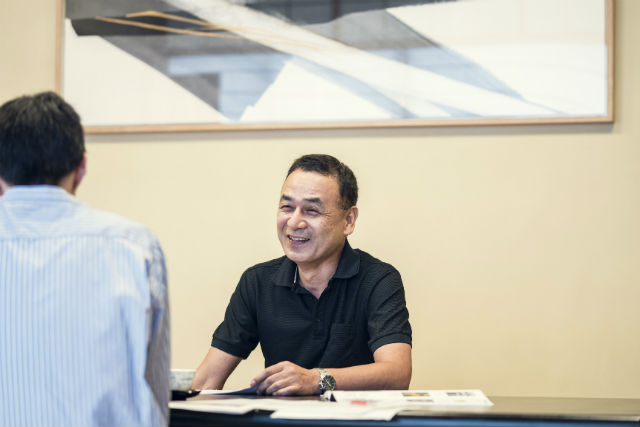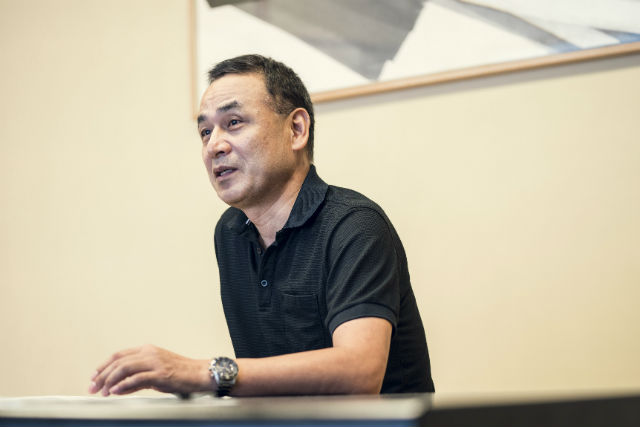Vietnamese Theater: Interpretations of the Producer-Director
Hatori: Please tell us how you spent your time in Vietnam.
Muneshige: I went intending to see as many shows I could, every chance I could get. In Hanoi, I went out to theaters nearly every day, and one thing I noticed was that the people doing theater were college graduates who were fairly well-off. Furthermore, once the structure of state-led theater became apparent, it gradually became clear to me that privileged people, essentially intellectuals and the wealthy class, were the ones backing theater. I was interested in people who had nothing to do with the field—people who were completely outside of theater—so I went out to the rural areas as much as possible. In Hanoi, I rented a room above a grocery store in the corner of the market. During the daytime, I spent time with the local people and listened to all kinds of stories, interacting with them on a more individual level. I travelled south from Hanoi over the course of a year and I tried to do the same thing; to create the same kind of interactive environment in Da Nang, Hue, and Ho Chi Minh City. I tried to enter the lives of these people who weren't in theater and observe as well as experience the diverse lifestyles.

Photo: Hiroyuki Muneshige
Muneshige: At weddings, for example, when the guests do acts to celebrate the occasion they come out on stage with such confidence that that also came to resemble theater to me. Thinking about theater as something that is not only on stage but also a part of everyday life, I realized it was important to also become familiar with how they think. So it was a very good experience for me.
Black Tent Theatre began with the idea of taking plays to locations that don't have theater. That aspect is very similar, I think. In Vietnam, theaters are considered the only places for drama and acting; the word "theater" itself is not used much in other contexts. In Hanoi, buying tickets to see a play is still a foreign custom for the ordinary, local people. So I think it's still something that's very limited to an exclusive group of people.
Hatori: So, do you mean both the custom of going to the theaters and also the people who do theater are both limited?
Muneshige: Yes. The usual track is to graduate from a theater or film university and move to building a career in the performing arts field. Moreover, to become a stage director, you would spend an extra two years in university and study theories in theater. Speaking only of Hanoi, I found that there aren't any private theater troupes, so in order to become an actor you'd have to graduate from a theater university. Otherwise, I don't think you can perform on stage.
Hatori: You say that in Hanoi, at least, there are not any private theater troupes. How about the other cities?
Muneshige: In Ho Chi Minh City, private theater troupes began to be able to get registered and licensed in the 2000s, so there is a framework in place for their operation and activities. I think there were around twelve to thirteen troupes. There is no support from the state, so they run on their own ticket revenues.
Hatori: So it's a registration system.

Muneshige: If the state doesn't issue a license, you just can't organize performances. The scripts obviously go through censorship, but you have to get permission even for the actual performances, too. You can't just decide one day to do a performance the next day; you have to follow several steps before you can stage something in public.
Hatori: How are those distinguished from things like village plays?
Muneshige: Village plays are performed at festivals. Throughout Vietnam, there are about 150 art organizations half of which are theater groups and the other half consists of groups working on traditional plays and musicals. Among them, twelve to thirteen groups are government sponsored. There are also groups that belong to the military and others belonging to Public Security Commission. There are also other theater troupes belonging to different levels in the country—the provincial, the ministry, the municipal—but they are treated completely different from contemporary theater.
Hatori: Are the people who do theater aware of or careful of other genres like traditional plays and musicals?
Muneshige: Their identity is deeply embedded in tradition and history, so they treat traditional plays and musicals with respect; they're very important to them. There are cases where Cheo*3 music or movements from the Tuong*4 are used in contemporary theater, so I think those in contemporary theater are trying to keep tradition alive, at least in one way or another.
The problem traditional theater confronts now is that there are no successors and there are fewer younger audiences. So in order to survive, it is trying to appeal to foreign tourists. The water puppet theater is the only kind of theater that is thriving, and in Hanoi, Da Nang, and Ho Chi Minh City alike, most of the spectators are foreign tourists.
*3 Cheo is a traditional Vietnamese opera that developed in a northern farming village where the Chinese influence was very strong. Dance and music are integrated with comical old tales to tell stories of people's techniques for getting through life and their good deeds. These are performed at festivals and such in the countryside.
*4 Tuong originated in northern Vietnam, but during the time of the Nguyen dynasty in the nineteenth century it reached Hue in the center of the country and flourished as a palace art. It consists largely of Chinese narratives and historical facts, as well as historical pieces dealing with things like power struggles within the palace and feudal warlords. This traditional Vietnamese theater is composed of three elements: theater, music, and dance. Hanoi Rekishi Kenkyukai [The Hanoi History Research Group] Website. Page on "Tuong."(Japanese)
Hatori: If that's the case, I assume the decrease in the number of audiences is a challenge both contemporary and traditional theater face.
Muneshige: With traditional theater, that's probably true. On the other hand, contemporary theater in Ho Chi Minh City is actually drawing in audiences; especially young ones. So the producers of private theater troupes are doing their best to capture the attention of younger people: they are very attentive to deciding the troupe's repertoires and also the performers, too. So now they are hiring popular TV actors and movie stars. They have about thirty to forty plays as their repertoire which they show daily and show each work over the course of about five years. That's similar to European theater groups, how they have a repertoire system.
Hatori: Do the audience sometimes enjoy same works performed by different actors?
Muneshige: Once they set a piece, they don't switch around the cast as much. The works are quite similar—they're pretty much about family or love stories. What're popular now are horror stories; shows with ghosts that surprise the audience are very popular.
Hatori: I skimmed through the website of one of the theater troupes based in Ho Chi Minh City, and there really are a lot of those horror plays. I can't quite imagine that they become the mainstream in other countries and regions. Unfortunately, I have never seen one myself; what is your take on them? What sort of characteristics do they have?

Muneshige: I found their sound effects quite unique. They first surprise the audience with sound effects. They make the stage completely dark and then choreograph a sudden appearance of something; and even for that, the effect of sound is really an important component.
Hatori: But that seems more like the element of surprise than conjuring up fear.
Muneshige: True, it's not very scary; but it is quite interesting. The stage designs or props are reused for other plays so they're not very realistic. But the acting itself is realistic. I think the actor's studying under instructors who learned the Stanislavski system*5 in China or Russia. Realism is costly, so it's inevitable that the stage designs end up becoming abstract; there will be an old well, for example, on stage that doesn't look like a well at all.
*5 A systematic method for training actors created by Moscow Art Theatre stage director and actor Konstantin Stanislavski, based on actual practice. Believing that the actor's creativity was to live or embody a role, his goal was to give shape to a human image bearing internal truth.
Hatori: Although it was only a few times, I also had the opportunity to see some public performances of local theater troupes in Hanoi and Ho Chi Minh City. And I agree, the set and stage design were relatively simple and made with panels that we could clearly tell were being reused for other plays. But seeing the audience enjoy the plays made me realize that maybe they have a very good imagination; they can imagine concrete settings from the abstract stage.
Muneshige: The audience go to the theater to simply enjoy themselves, I think, so I suppose they're not too concerned about how "real" or realistic things are. Ho Chi Minh City's private theater troupes don't do literary works, for the most part, and I think that's because they focus more on comedy or entertainment. I think people just want to laugh and enjoy the play.
Also, there are several people who, although have graduated from college but couldn't find work in a theater troupe, have joined together in search of the means and arena to work on their theater work. They obviously don't have funding or a theater. So there is a movement emerging where groups like that temporarily rent rooms at cafes or restaurants to hold trial performances regularly.
Hatori: Do those trial performances in cafes also have to apply for licenses?
Muneshige: I think they're doing that without the license; tickets are sold over the counter and information about their performances is not as widely known. I'm curious too, so I will ask about it next time.







